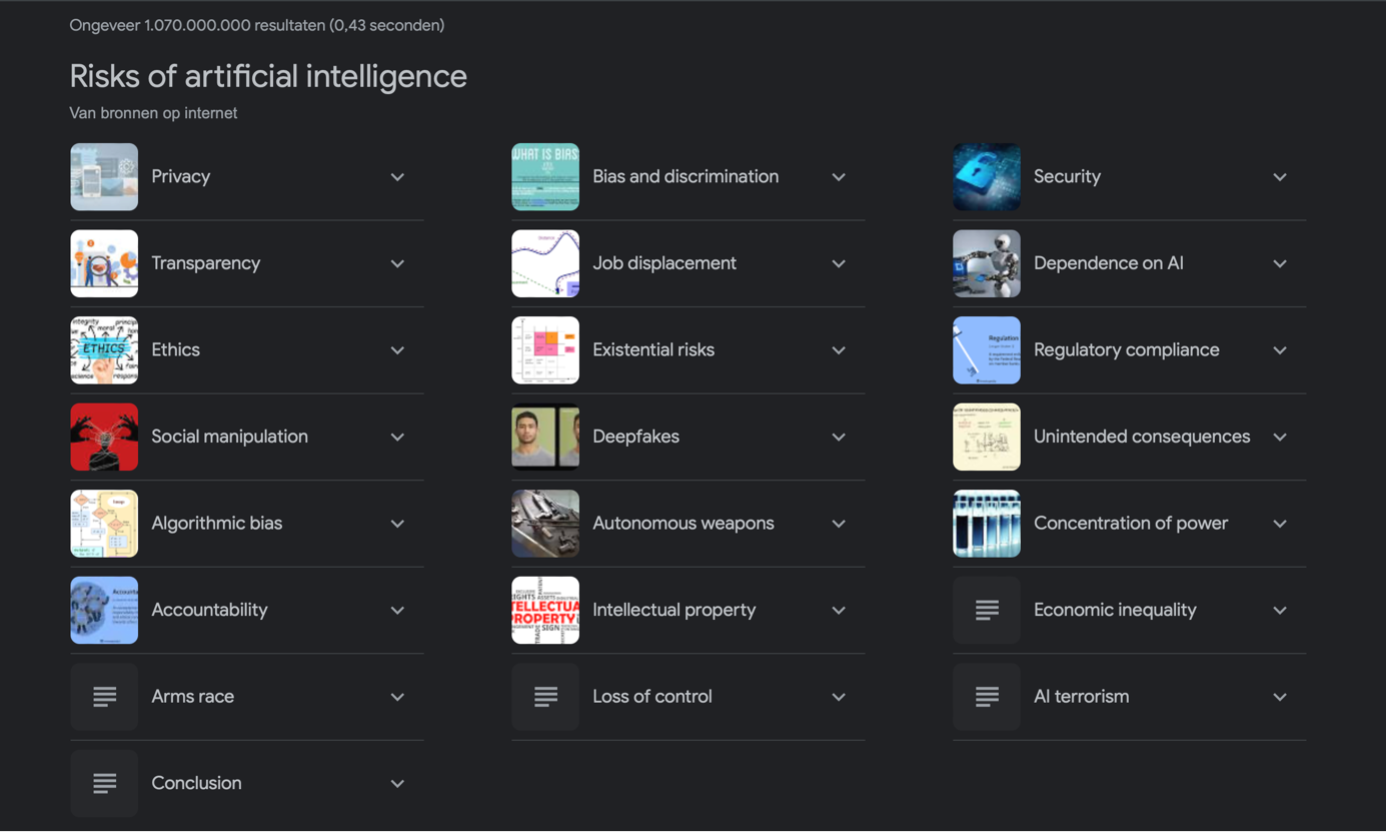De onstuimige groei van AI brengt veel risico’s en uitdagingen met zich mee. Zoek maar eens op Google en je wordt overspoeld. AI biedt geweldige kansen maar er zijn ook risico’s waar we goed op moeten letten.
A lot of risks and challenges are associated with the growth of AI and its widespread adoption. A simple search on Google, “the potential risks of AI” and you get this:

The above-mentioned risks can be divided in different categories, so let’s focus on the risks that relates to the test occupation. I made a selection myself as I identified the following risks:
• Lack of Transparency
• Privacy
• Security
• Dependence on AI
• Job Displacement
I read a lot of articles to find out what the risks contain for us as testers. You can find a list of these articles at the end.
Lack of Transparency
People don’t understand why AI models make the decisions they do. Understanding how AI systems make decisions is crucial for building trust and ensuring accountability. However, many AI models, particularly deep learning ones, operate as “black boxes,” making their decision-making processes opaque and challenging to interpret. This lack of transparency not only breeds distrust, but also raises ethical and legal concerns, especially in critical areas like healthcare and defense. To address this issue, the development of explainable AI (XAI) is essential. XAI aims to provide clear and understandable explanations for AI decisions by tracing back the specific data and reasoning that led to them. By enhancing transparency through XAI techniques and policy measures, such as transparency requirements, we can foster trust in AI systems and ensure they are used responsibly and fairly. Ultimately, promoting transparency in AI is paramount for fostering acceptance and maximizing the benefits of this transformative technology while mitigating potential risks.
Privacy
We as testers work with test data for which we need to be sure that this data is untraceable to a person. The rise of AI technologies brings forth significant concerns regarding data privacy and security. These technologies often entail the collection and analysis of vast amounts of personal data, leaving users vulnerable to risks like data breaches, identity theft, and surveillance. Mitigating these risks requires strict enforcement of data protection regulations and the adoption of privacy-preserving techniques such as encryption and anonymization. Empowering users with control over their data is crucial. The lack of comprehensive regulations make these concerns worse, with few laws addressing AI-specific data privacy issues on national or international levels. While efforts like the EU’s proposed AI Act aim to regulate high-risk AI systems, comprehensive frameworks are yet to be established. As AI becomes increasingly integrated into daily life, the importance of safeguarding privacy rights through robust measures and collaborations among policymakers, technologists, and privacy advocates cannot be overstated. It’s imperative to address these challenges to ensure individuals’ privacy rights are upheld in an AI-driven world.
Security
The advancement of AI technology brings not only opportunities but also significant security risks. AI systems, like any technological infrastructure, are susceptible to cyber attacks. Hackers can exploit AI capabilities to orchestrate sophisticated cyberattacks. Enhancing security involves designing resilient AI systems and implementing ethical frameworks. International cooperation is crucial to establish norms and regulations safeguarding against AI security threats. It’s imperative to address these challenges to ensure responsible and secure AI development and deployment.
Dependence on AI
The widespread use of AI technologies raises concerns about overreliance and potential addiction among users. Dependence on AI assistants for information or entertainment can lead to compromised critical thinking and social skills. Moreover, as AI increasingly understands and customizes our experiences, it may erode essential human qualities like patience, empathy, and creativity. This overreliance could lead to a loss of human influence in decision-making processes, particularly in critical areas like healthcare and creative endeavors. Striking a balance between AI assistance and human input is crucial to preserving our cognitive abilities and maintaining meaningful human interactions in an increasingly automated world. As testers, we are critical thinkers. We must always question the information coming from an AI.
Job Displacement
AI technologies present a double-edged sword for the workforce, promising increased efficiency but also threatening widespread job displacement. As AI-driven automation infiltrates various industries, routine tasks are being swiftly replaced, posing a significant challenge for low-skilled workers. This shift has sparked concerns about rising economic inequality and the potential loss of purpose and identity associated with traditional employment. While some argue that AI will create more jobs than it eliminates, the reality is a complex transition that requires proactive measures.
However, the impact of AI isn’t limited to low-skilled sectors. Even professions requiring advanced degrees, such as law and accounting, face disruption as AI technologies streamline tasks like contract review and financial analysis. While automation offers potential benefits in terms of efficiency and accuracy, it also raises questions about the future of human employment and the societal implications of a workforce increasingly reliant on machines.
In response to these challenges, experts advocate for proactive measures such as worker retraining programs and policy changes to support displaced workers and facilitate the acquisition of new skills. Additionally, fostering a culture of lifelong learning and adaptability is essential for individuals navigating the rapidly evolving job market. Ultimately, embracing AI technologies requires a holistic approach that prioritizes human-centric solutions to mitigate the potential negative impacts on the workforce and ensure a prosperous future for all.
We as testers already faced some problems in the past, where there was a strong believe that automation would replace the tester. Still, we are there as our critical thinking and creativity is still key to do a good test job. Even developers replacing testers by doing the (automated) test work was not a success. The reason is that you first have to test before you can automate. Developers say that the test work is not something we must do (except unit testing, but that is a part of development).
Conclusion
We must provide clear explanations for the decisions made when utilizing AI to aid in decision-making. It’s essential to handle the diverse data we access responsibly, ensuring compliance with privacy regulations, especially when dealing with personal data. We must prioritize the security of the AI systems we employ. While AI can enhance our testing processes, it’s crucial to maintain a critical perspective. It’s important to recognize that AI serves as an assistant rather than a replacement, viewing it as a collaborative partner or co-creator.
AI is fast but not smart. We as humans (luckily, testers are also humans) provide information to AI. If we ask AI something, we get a quick response. But be aware that when you put garbage in AI, you will get garbage out.

